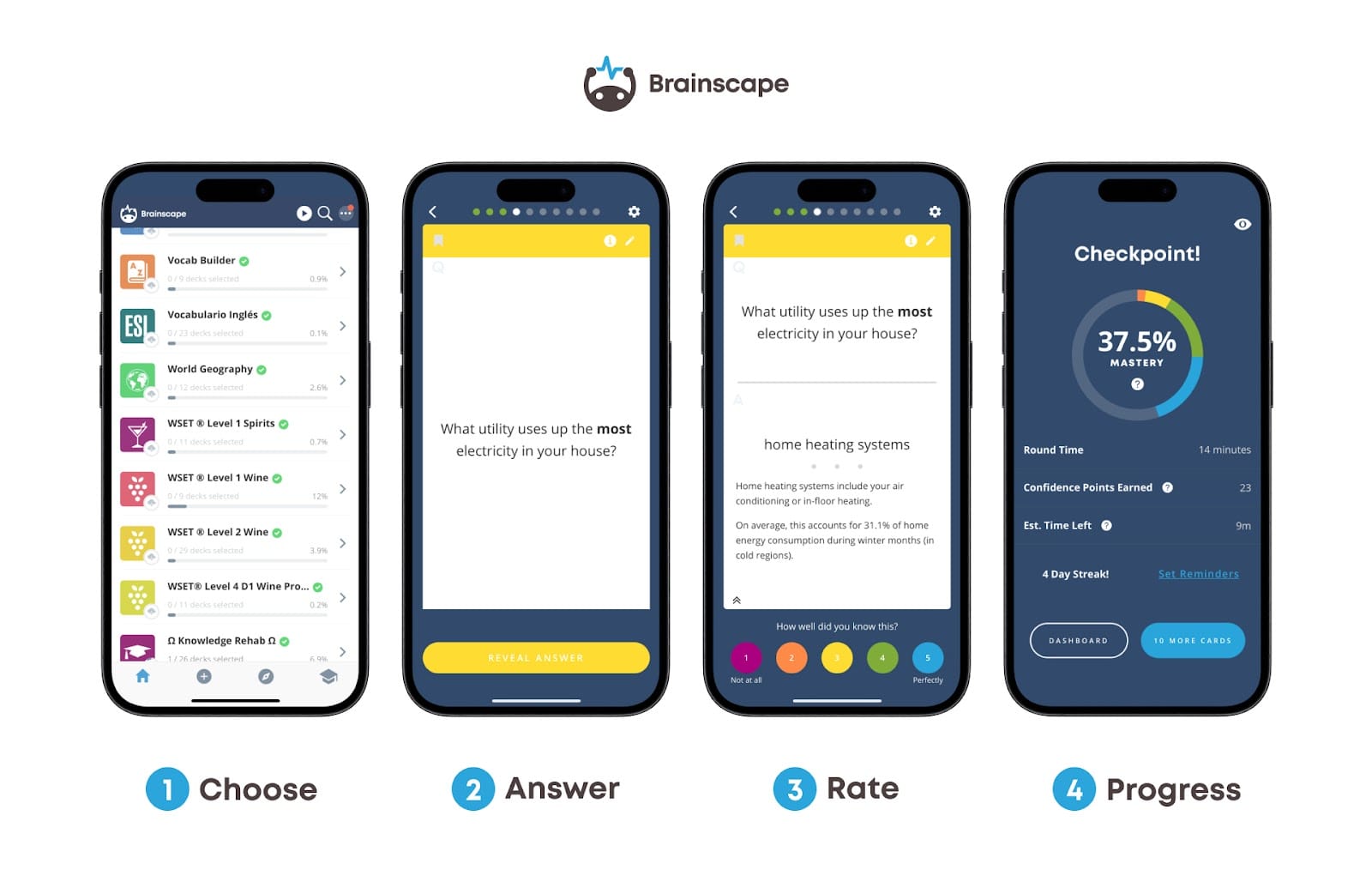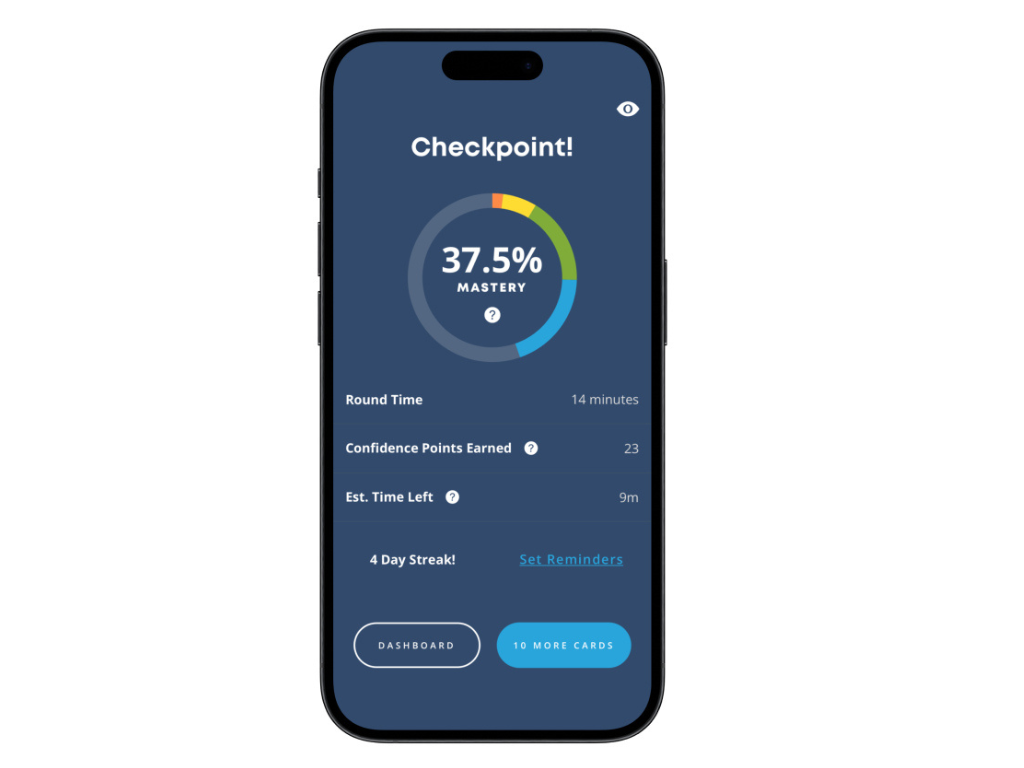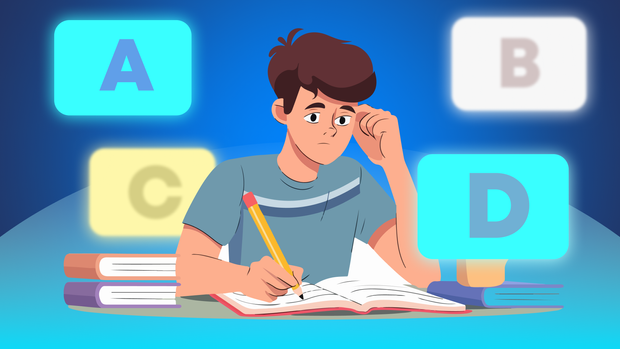Multiple-choice exams are both a blessing and a curse. They’re the only test format where the answer is literally staring you in the face—but it’s also sitting next to three or four other answers that look suspiciously similar.
On the one hand, it may feel like a relief to hear that your exam is multiple-choice because even if you’re clueless, guessing will get you a correct answer 20-25% of the time. On the other hand, the psychology of decision-making (and decision fatigue) and good ol’ exam stress can make these tests thoroughly challenging!
Most importantly, however, answering multiple-choice questions is a horrible way to practice for exams (and we’ll explain why shortly).
For these surprising reasons, we put together this guide on the psychology of multiple-choice tests, which we packed with the insights, tips, and strategies you need to confidently crush these types of assessments. (This’ll also be useful to you if you’re an educator!)
First, let’s take a look at the psychology of multiple-choice exams and why—in spite of classroom folklore—any hacks you might have heard about sniffing out the correct answer (short of simply knowing the information well) are simply woo-woo…
First things first: the secret to crushing multiple-choice exams…
I won’t bury the lead here.
The best way to ace a multiple-choice exam is to know the facts. You’ve got to know the facts well enough to tease them out of a list of options, many of which may be distractingly similar. Remember that.
If you were hoping for a sneaky shortcut to figuring out how to answer multiple-choice questions accurately, there simply isn’t one; although, there is a study tool that will help you learn those facts way more efficiently than trawling through your textbook with a highlighter… and we’ll talk about that in a bit.
Your first instincts aren’t always correct
There is a common myth that trusting your first instinct is the best way to ace multiple-choice tests. But that’s false.
Your brain uses two types of thinking: System 1 (fast, intuitive thinking) and System 2 (slow, analytical thinking). Which one do you think is better for answering test questions?
System 2, right? After all, that’s where your analytical thinking takes place!
In a high-stakes test situation, System 1 will kick in by intuitively recognizing which option is the best answer. If you don’t know the answer with 100% certainty, you’ll probably experience this as a “feeling” that B, for example, is the correct answer. Where does this “feeling” come from?
As many expert private tutors in maths and physics note, that “feeling” comes from your brain subconsciously recognizing patterns and recalling similar problems you've solved before. It's a valuable guide, but it shouldn't replace careful reasoning, especially when a question is tricky or deliberately designed to mislead.
If you’ve studied really hard and know your subject extremely well, it comes from your knowledge base; your experience. But System 1’s intuition can also be triggered by recognition or some kind of psychological bias as silly as having recently had a conversation with a friend about something related.
Immediately after your initial thoughts are born, System 2 kicks in to analyze this feeling, either qualifying it as probable or rejecting it as false.
Either way, simply trusting your intuition is a terrible multiple-choice strategy. You should deliberately consider all of your answers, no matter how powerful your instincts may feel.
Here’s an interesting factoid: students who change their answers are more likely to change from wrong to right than any other outcome. So if you do change your mind, don’t get superstitious about it. Try to think it through logically and go with the answer that makes the most sense.
Strong judgment and metacognition are useful tools in multiple-choice exams
Students who do well on multiple-choice exams have strong judgment. They are highly aware of their own knowledge and can always assess how well they know an answer. If they’re confident, they don’t need to change that response. But if they’re unsure of an answer, they’re willing to question and change it.
(The term for this awareness is metacognition: thinking about your thinking.)
Being aware of your confidence level for each piece of knowledge is key to making this call. Students who know how well they know their facts can make the best decisions about sticking with their original answer or changing to something better.
The best way to get good at this is to practice assessing how well you know the answer to a question. And the easiest way to do that is to work through flashcards, which frame all the facts you need to learn as question-and-answer pairs.
I’m not talking about paper flashcards, which are so last century, but digital flashcards that have spaced repetition baked into their study algorithms. This brings me to that study tool I mentioned earlier.
Brainscape is a flashcard app that asks you to rate how well you know the answer to every flashcard on a scale of 1 to 5 with 1 being “not at all” and 5 being “totally”. Your confidence rating then informs the app’s algorithm how frequently to repeat that flashcard: more often if you rated it a 1 or 2 and much less often if you rated it a 4 or 5.

Thinking about your thinking is an effective tactic to employ when you want to learn fast, and using a flashcard app like Brainscape is an excellent way to automate that practice.
The difference between recognition and recall
The problem with multiple-choice practice is that it does not engage active recall, but just passive recognition. The correct answer is already in the mix, and you just have to identify it. Easy!
Unfortunately, it’s a bit too easy. Passively recognizing an answer doesn’t train your brain to actively recall it "from scratch".
(It’s a bit like the difference between writing a joke yourself and selecting a ready-made punchline in 'Cards Against Humanity'. One of those develops your creativity and comedy chops; the other develops your ability to play a card game.)
Instead of multiple choice, your study should focus on answering questions through active recall. You read the question; you provide the answer without the crutch of multiple-choice options; and you check if you’re right. Active recall forces your brain to form connections and test them. Choosing an answer that’s in front of you simply does not.
If you do study with multiple-choice practice tests to get a feel for the exam, use it as a chance to get inside the test writer’s head. The incorrect options aren’t selected at random. When teachers are trained to write multiple-choice tests, they’re instructed to target common student errors and include them as the wrong options.
Once you’ve done a practice test, examine the wrong options and see if you can guess what kind of error would lead to them. It’ll help you better understand the common mistakes and mental "typos" to avoid.
The risk of decision fatigue in multiple-choice assessments
Making decisions—especially when the stakes are high—drains your mental energy. This is called decision fatigue, and it’s why you may find yourself floundering halfway through your exam, second-guessing answers you were confident about 20 minutes ago.
Multiple-choice exams are a marathon of micro-decisions. By the time you’ve answered 20 or 30 questions, your brain starts to protest, “I’m done. Let’s just pick C for everything.” It’s a real psychological phenomenon and if you’re not careful, it can sabotage your entire test.
But don’t worry! We’ve researched some multiple-choice test strategies that’ll help you dodge decision fatigue like a pro...
How to answer multiple-choice questions: test strategies that actually work
Alright, let’s cut to the chase. You want to know how to dominate your next multiple-choice exam, right? These strategies are your secret weapons:
#1 Cover up the multiple-choice list and answer from your memory
This is one of the most powerful strategies you can employ when answering multiple-choice exams. Cover up the multiple-choice answers provided and try to answer the question from your memory. Once you have your answer in mind, look for it in the list of options provided. This will prevent you from getting distracted/confused by the multiple choices on offer.
#2 The process of elimination is your BFF
If you don’t know the answer outright and are uncertain about the options provided, start by eliminating the obviously wrong answers. Even if you’re not sure of the right one, knocking out the wrong ones boosts your chances of success (because, you know, math).
#3 Read the question carefully, and then the answers
Sounds simple, but it’s easy to get tripped up. Read the question carefully and attempt to answer first before you look at the answer choices. You want to understand what’s being asked without getting distracted by those tricksy answers. Then, when you do regard the answers, read them carefully. If examiners want to discern your precise knowledge and attention to detail, they might throw you a tricksy set of answers to choose from!
#4 Watch out for absolutes
Words like always, never, none, and all tend to be red flags. Very few things in life (or in multiple-choice tests) are that cut and dried. If you see an absolute, approach it with caution—it could be a trap.
#5 Answer the questions you know first
If you’re stuck on a question, don’t waste time agonizing over it. Skip it and move on to the ones you’re more confident about. You can always circle back later with fresh eyes. This is not only essential for good time management but knocking out a bunch of questions you know the answers to improves your confidence and gives you time to get over your initial exam nerves.
#6 Bookmark questions you're unsure of for later review
As mentioned before, knowing how well you know your materials is clutch. After each question, quickly consider how sure you are of your answer. Unsure? Put a star next to that one for a possible change later on once you’ve answered the rest of the questions you’re confident in.
#7 Take a mental break
No, you can’t get up and take an afternoon off at the beach, but you can take a few deep breaths and reset your focus. Mini-mental breaks during the exam can help you stay sharp and avoid decision fatigue.
How to study for a multiple-choice exam
Now that you’re armed with test strategies, let’s talk about the best way to study for these exams. Spoiler: it’s not cramming. Multiple-choice exams test your ability to recognize correct information, not just regurgitate it. This means you need a different approach to studying. Here’s how:
Active recall is key
Don’t just passively read your notes or highlight your textbook. Engage with the material by quizzing yourself. Flashcards are excellent for this because they force you to recall information actively. (Check out our guide to the difference between active recall and recognition.)
Prepare those confidence levels
Every time you study a fact, build the habit of switching between brain System 1 and System 2. When you provide your answer, ask yourself how well you knew it. Just this little act of self-reflection is proven to enhance memory retention!
Practice, practice, practice
In the exam, you answer questions. That’s what you should do when studying too. However, multiple-choice practice questions risk the common study mistake of passive studying. Use systems that force you to generate an answer by yourself, rather than merely spotting it on a list. (Tip: here’s how flashcards supercharge effective studying.)
For more on why multiple-choice questions are a terrible idea while studying, check out this video:
Now, for a study tool that embodies ALL of the above-mentioned study tactics...
Crush your multiple-choice tests (or any test) with digital flashcards
The flashcard app Brainscape is the ultimate learning tool for preparing for multiple-choice exams... or any knowledge-based exam for that matter.

Brainscape uses spaced repetition, a science-backed learning tactic that systematically ingrains information over time, instead of cramming it all in the night before. Think of it as training your brain to store info in its long-term memory vault, not just the "use it and lose it" short-term files.
The app also taps into active recall by quizzing you on the material in a way that forces your brain to work for the answer; recalling it from scratch rather than passively recognizing it in a list of answers. (This is the same principle behind why self-quizzing is more effective than passive reading.)
Oh, and did we mention the metacognition? Every time you see a card in Brainscape, you rate it from 1 to 5 for how well you know it, thereby compelling you to self-assess your confidence.

Brainscape’s algorithm tracks how well you know each concept and adjusts the repetition frequency accordingly. You’ll spend more time on the things you don’t know and less on the things you’ve already mastered. It’s like having a personal tutor in your pocket—minus the guesswork.
By leveraging all of these learning tactics—spaced repetition, active recall, and metacognition—Brainscape's digital flashcards will help you learn TWICE as efficiently for any test or exam and remember for far longer, too!
Final thoughts: Use the psychology of multiple choice to ace your next test
Multiple-choice exams don’t have to be a nightmare. With a little psychology, some proven test strategies, and the right study tools, you’ll be breezing through those ABCD choices in no time.
Remember: knowing how well you know information and spaced repetition are your secret weapons. Use flashcards that assess your confidence for peak performance!
Now go smash that test as if it was always your destiny. (It was, and is.) You’ve got this!
Check out Brainscape’s extensive collection of flashcards and educational tools designed to sharpen your skills and help you ace your confidence levels for your next multiple-choice exam! Plus check out the Brainscape Academy for more exam prep tips from experts in cognitive science and education:
- Use metacognition strategies to enhance your studying
- ADHD test-taking strategies & study tips
- The 20 best test-taking strategies used by top students
Sources
- Baer, T., & , S. (2021). Quantifying the cost of decision fatigue: Suboptimal risk decisions in Finance. Royal Society Open Science, 8(5). https://doi.org/10.1098/rsos.201059
- Couchman, J. J., Miller, N. E., Zmuda, S. J., Feather, K., & Schwartzmeyer, T. (2015). The instinct fallacy: The metacognition of answering and revising during college exams. Metacognition and Learning, 11(2), 171–185. https://doi.org/10.1007/s11409-015-9140-8
- Kruger, J., Wirtz, D., & Miller, D. T. (2005). Counterfactual thinking and the first instinct fallacy. Journal of Personality and Social Psychology, 88(5), 725–735. https://doi.org/10.1037/0022-3514.88.5.725
- Merry, J. W., Elenchin, M. K., & Surma, R. N. (2021). Should students change their answers on multiple-choice questions? Advances in Physiology Education, 45(1), 182–190. https://doi.org/10.1152/advan.00090.2020
- Tay, S. W., Ryan, P. M., & Ryan, C. A. (2016). Systems 1 and 2 thinking processes and cognitive reflection testing in medical students. Canadian Medical Education Journal, 7(2). https://doi.org/10.36834/cmej.36777
